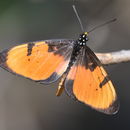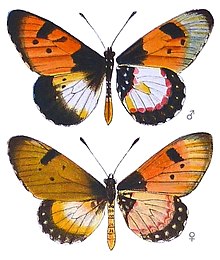ar
الأسماء في صفحات التنقل


Acraea anemosa, the broad-bordered acraea, is a butterfly of the family Nymphalidae which is native to southern Africa and coastal East Africa.
It is found in Zululand, Eswatini, Transvaal, Zimbabwe, Mozambique, Malawi, Zambia, southern Zaire (Shaba), Namibia, Angola, Tanzania, the coast of eastern Kenya and southern Somalia.
It is a variable species with a number of described colour morphs including f. anemosa, f. arctitincta, f. mosana, f. welwitschii, f. nivea, f. alboradiata and f. lobemba. The wingspan is 50–55 mm for males and 57–64 mm for females.
A. anemosa Hew. Forewing above ochre-yellow to orange-yellow, at the base deep black to vein 2, the black colour sharply defined, at the distal margin with sharply defined black apical spot about 4 mm. in breadth and fine marginal line; a small median dot; discal dots 4 to 6 large and connected, 1b to 3 usually small or absent, the dot in 1b placed somewhat nearer to the distal margin than that in 2; hindwing above at the base and at the distal margin broadly black, and with a reddish yellow, unspotted median band. Forewing beneath coloured and marked as above; hindwing at the base and in the marginal band dotted with white; median band reddish white, proximally and distally with large red spots, which meet at the inner margin. Damaraland, Transvaal, Rhodesia; Portuguese, German and British East Africa.

A. welwitschi so nearly approaches anemosa that it seems to me [Aurivillius] to be scarcely an independent species. The sole difference consists in the forewing having a dark marginal band extending from the apex to the hinder angle and becoming gradually narrower posteriorly. In some forms this band is so narrow behind vein 4 that it is little broader than the marginal line in anemosa. Such forms can only be distinguished from by having the hindwing above white in the middle.
Adults are on wing year round in warmer areas with a peak from September to May in southern Africa. In cooler areas, adults can only be found from September to May.[5]
The larvae feed on Adenia venenata.
Acraea anemosa is a member of the Acraea anemosa species group. The clade members are:
Classification of Acraea by Henning, Henning & Williams, Pierre. J. & Bernaud
Acraea anemosa, the broad-bordered acraea, is a butterfly of the family Nymphalidae which is native to southern Africa and coastal East Africa.
Acraea anemosa es una especie de lepidóptero de la familia Nymphalidae. Es originaria de Sudáfrica, Suazilandia, Zimbabue, Mozambique, Malaui, Zambia, sur de Zaire (Shaba), Namibia, Angola, Tanzania, Kenia y sur de Somalia.
Tiene una envergadura de alas de 50-55 mm para los machos y 57-64 mm para las hembras. Los adultos vuelan durante todo el año en las zonas calurosas, con picos en septiembre a mayo en el sur de África. En las regiones más fría, los adultos solo se encuentran desde septiembre a mayo.[2]
Las larvas se alimentan de Adenia venenata.
Acraea anemosa es una especie de lepidóptero de la familia Nymphalidae. Es originaria de Sudáfrica, Suazilandia, Zimbabue, Mozambique, Malaui, Zambia, sur de Zaire (Shaba), Namibia, Angola, Tanzania, Kenia y sur de Somalia.
Tiene una envergadura de alas de 50-55 mm para los machos y 57-64 mm para las hembras. Los adultos vuelan durante todo el año en las zonas calurosas, con picos en septiembre a mayo en el sur de África. En las regiones más fría, los adultos solo se encuentran desde septiembre a mayo.
Las larvas se alimentan de Adenia venenata.
Acraea anemosa is een vlinder uit de familie van de Nymphalidae.[1] De wetenschappelijke naam van de soort is voor het eerst geldig gepubliceerd in 1865 door William Chapman Hewitson.
Bronnen, noten en/of referentiesAcraea anemosa là một loài bướm ngày thuộc họ Nymphalidae. Nó được tìm thấy ở Zululand, Swaziland, tỉnh Transvaal, Zimbabwe, Mozambique, Malawi, Zambia, miền nam Zaire (Shaba), Namibia, Angola, Tanzania, bờ biển của miền đông Kenya và miền nam Somalia.
Sải cánh dài 50–55 mm đối với con đực và 57–64 mm đối với con cái.[2].
Acraea anemosa là một loài bướm ngày thuộc họ Nymphalidae. Nó được tìm thấy ở Zululand, Swaziland, tỉnh Transvaal, Zimbabwe, Mozambique, Malawi, Zambia, miền nam Zaire (Shaba), Namibia, Angola, Tanzania, bờ biển của miền đông Kenya và miền nam Somalia.
Sải cánh dài 50–55 mm đối với con đực và 57–64 mm đối với con cái..